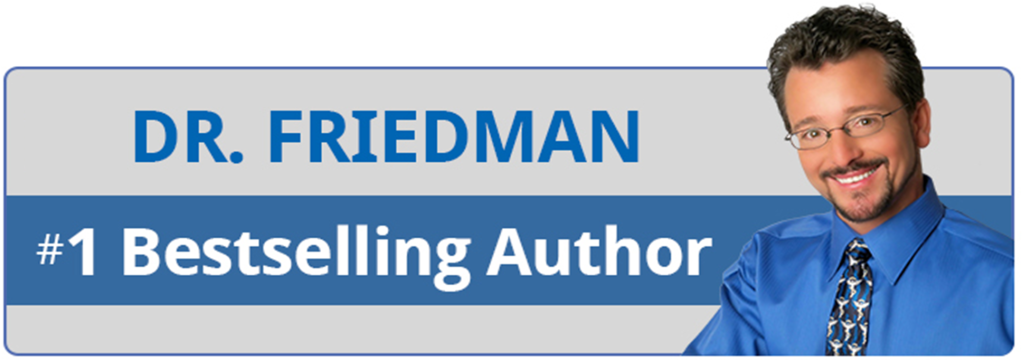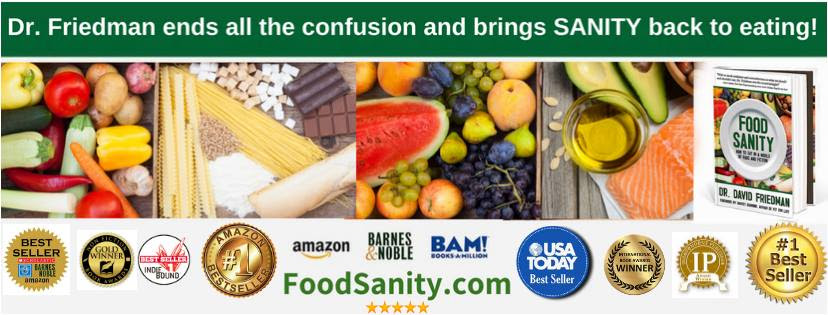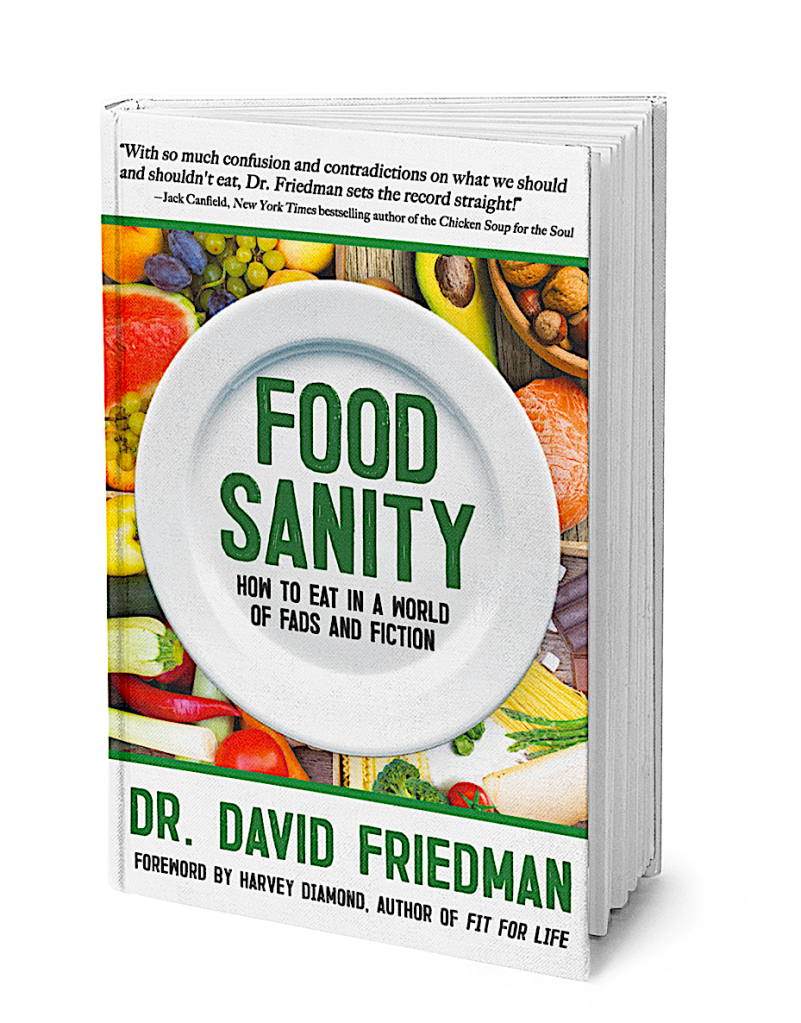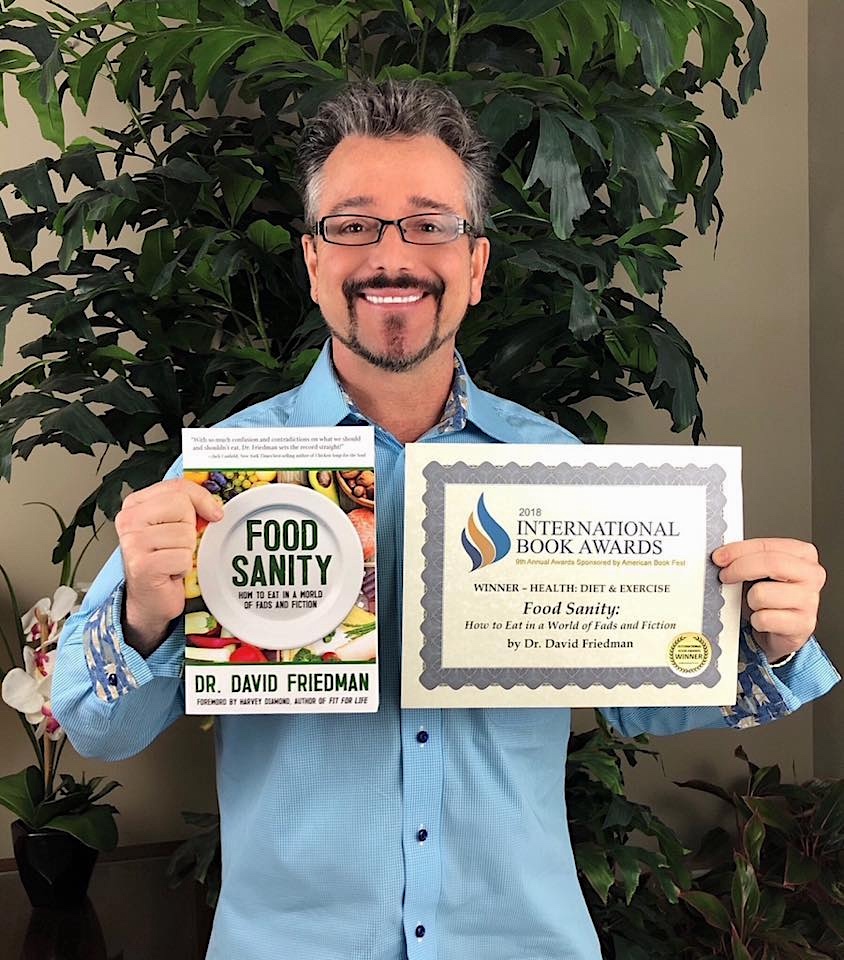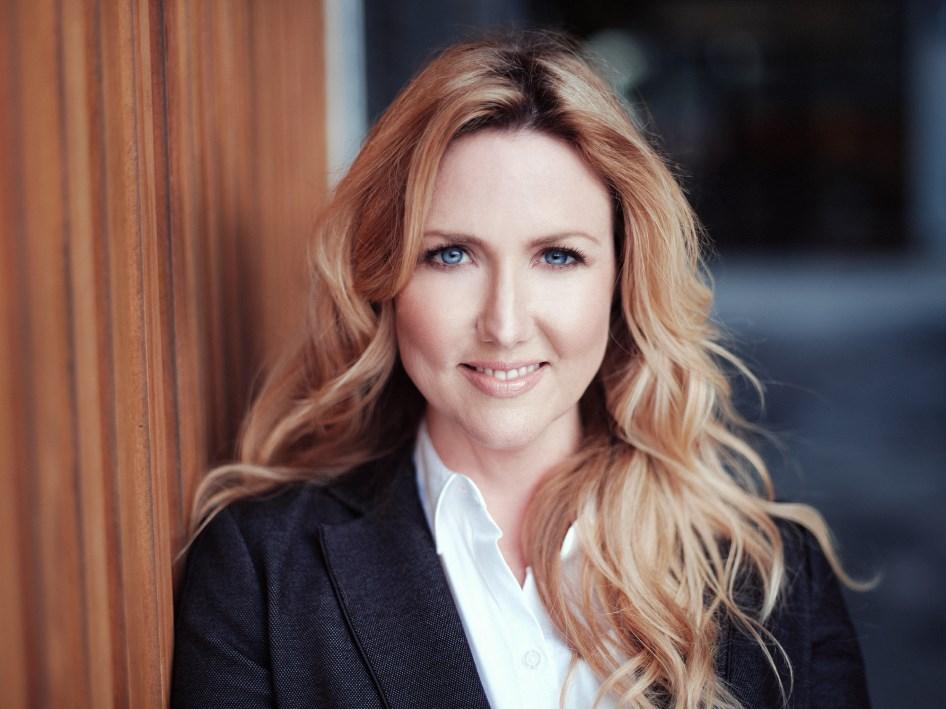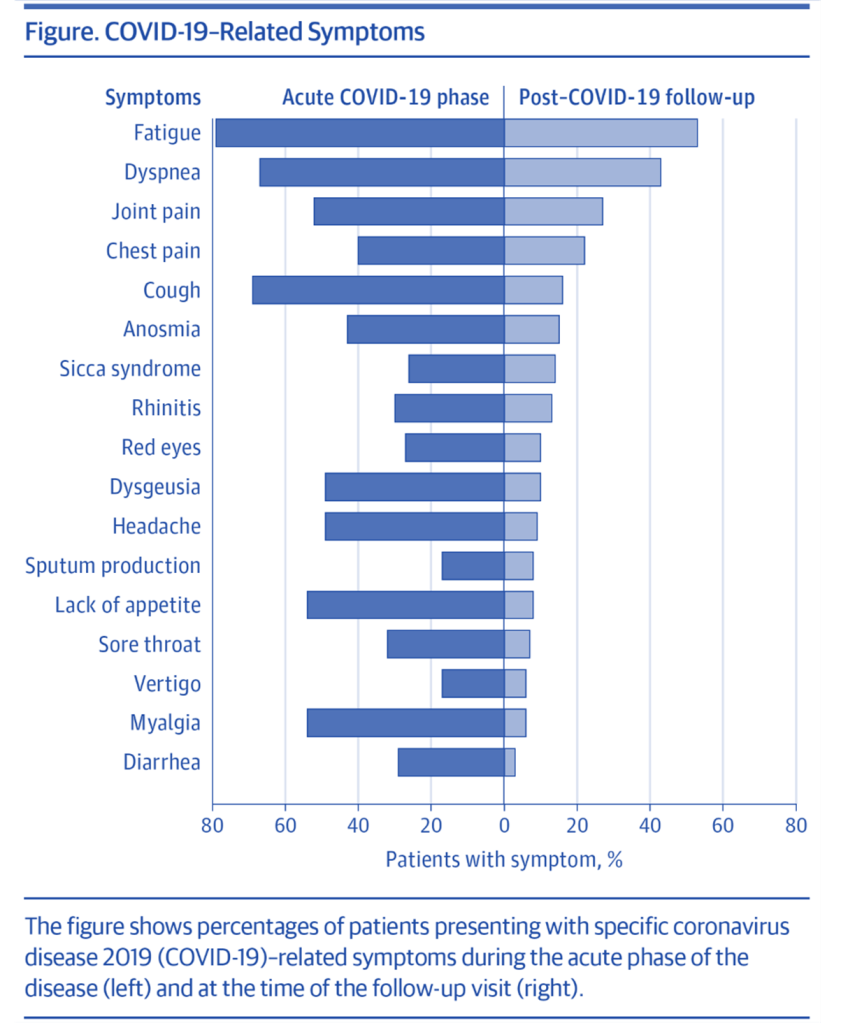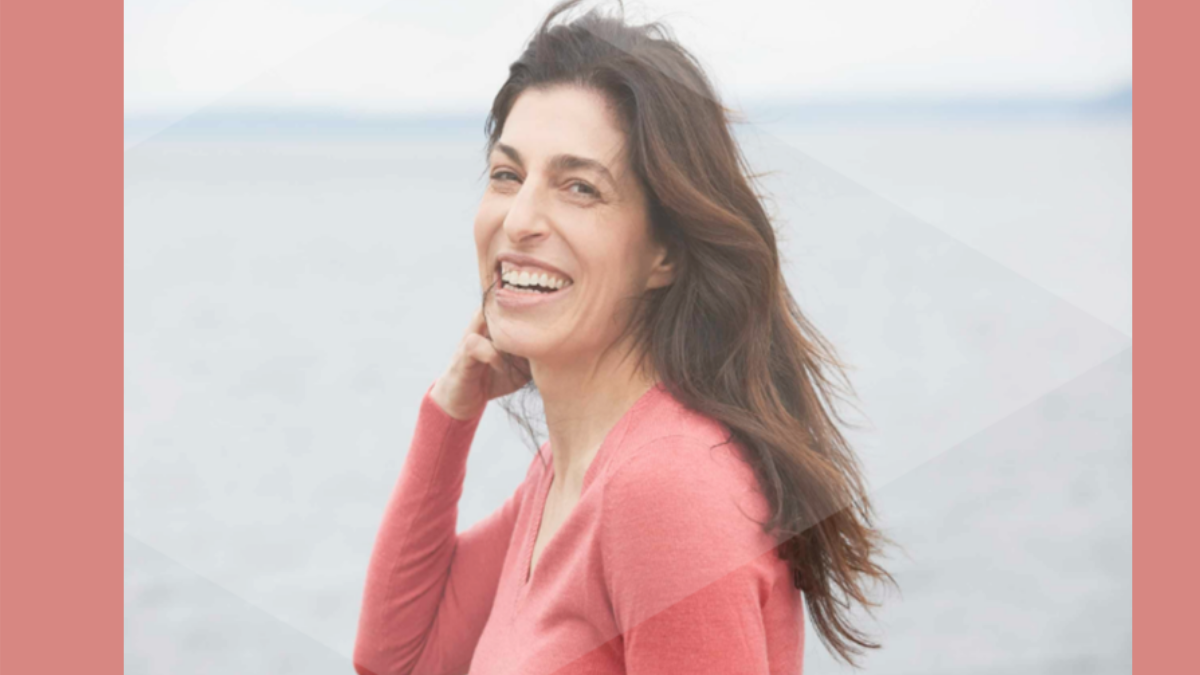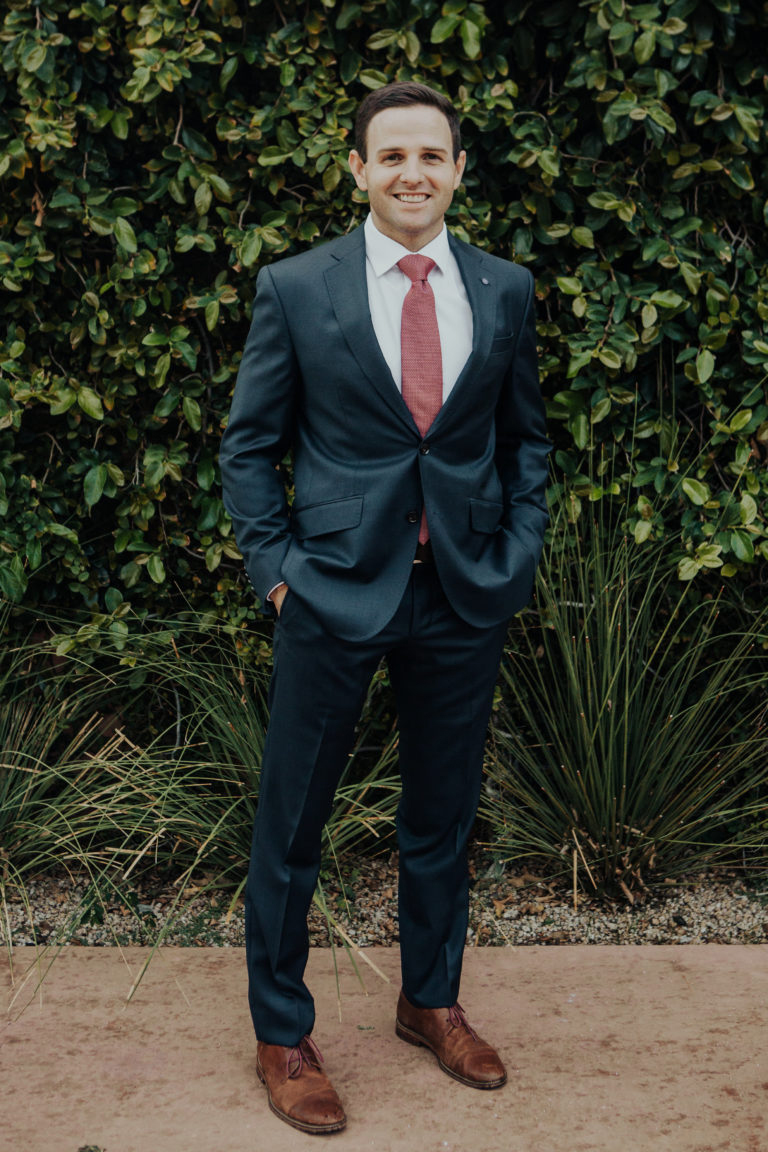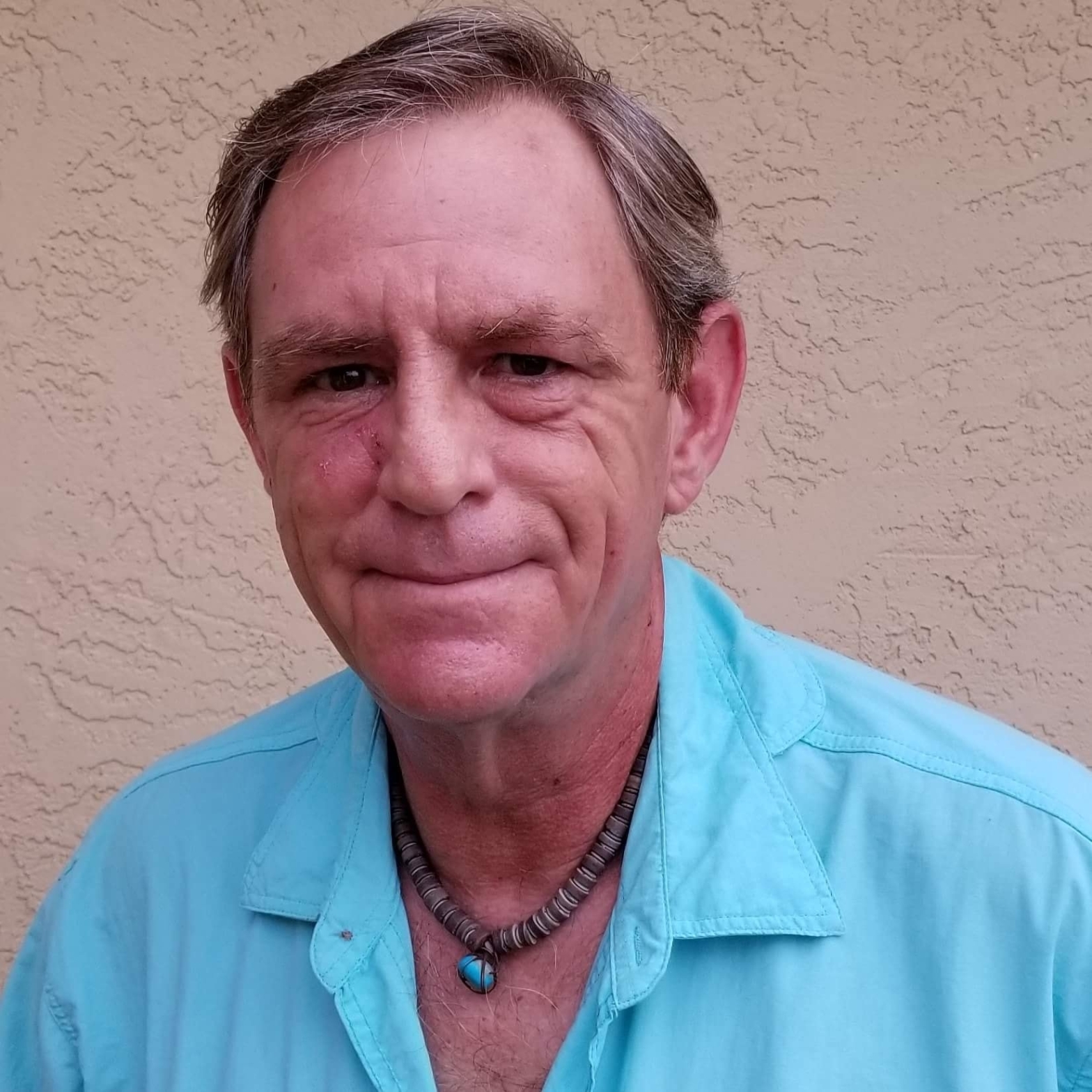When it comes to influential doctors, there is no one more qualified to hold that title than Dr. David Friedman! From teacher, doctor, best-selling author, keynote speaker, syndicated TV, and radio host, to successful entrepreneur, he’s done it all! Dr. Friedman’s education includes Doctor of Naturopathy, Clinical Nutritionist, and Chiropractic Neurologist. Friedman has also received a post-doctorate certification from Harvard Medical School, is a Board Certified Alternative Medical Practitioner, and is Board Certified in Integrative Medicine. He’s a former teacher of neurology, author of a college textbook on neuroanatomy, and a contributing writer for a plethora of leading magazines including U.S News & World Report, Newsweek, Readers Digest, Better Nutrition, AARP Magazine, and Woman’s Word. His multiple award-winning, #1 national best-selling book, Food Sanity, How to Eat in a World of Fads and Fiction, has created a paradigm shift in how people look at the food they eat.
Dr. Friedman’s list of clients has included many top celebrities like John Travolta, Jenny McCarthy, Jamie Lee Curtis, Anthony Hopkins, Val Kilmer, and Paul Newman, to name a few. Many fly across the country to see him because they trust no one else. As the health expert for Lifetime Television’s syndicated morning show and host of To Your Good Health Radio, millions of people have enjoyed his weekly, cutting-edge solutions to everyday health and wellness issues. He’s been a guest on over a hundred syndicated radio and television shows and his bestselling CD, America’s Unbalanced Diet, has sold over a million copies, helping to raise awareness about the unhealthy foods people are consuming. Add to his amazing resume, CEO and product formulator for an international nutrition company and it begs the question, how can he possibly accomplish all of this in one lifetime? Dr. Friedman was able to carve out some time in his busy schedule to chat with Influential Doctor’s Magazine so we could dig a little deeper into the disciplined mindset of this extraordinary doctor.
IDM: You have quite the resume of achievements. What has kept you motivated over the years to achieve so much success in life?
David: “The word “NO” has always been my biggest motivator. When someone tells me, “You can’t,” my ears remove the “t.” As an overachiever, people think success just runs in my genes. The truth is success did not come easy for me. As a child, I suffered from A.D.D (Attention Deficit Disorder.)
I could not focus and follow through with tasks. Because of this, I ended up always tardy, in detention, and failing most of my classes. While many parents offered their kids money when they made an A, my mom gave me $20 for every D I earned as an incentive to work harder to avoid getting so many F’s on my report card. At the time, I dreamed of being a musician and I felt that sitting in a classroom learning about history and math was a giant waste of my time! While most kids enjoyed their summer breaks, I always ended up in summer school.”
Friedman goes on to share, “Even though my SAT scores were great, no college would consider me because I ‘never applied myself in school.’ It would be the words said to me by my high school principal that would forever alter my path. ‘David be glad a college won’t accept you because you would end up failing. You’re just not smart enough!’ Those stabbing words he said that day resonated in my spirit.
One gift I did possess was writing. Using this talent, I submitted a very creative essay on why I should be accepted to college even though I didn’t make the best grades. I sent this with my application to several colleges and, to my total surprise, two of them sent me back an acceptance letter. On the first day of college, I put a sticky note on my dorm room mirror that said, ‘David, you’re not smart enough for college!’ Those words from my high school principal would fuel my motivation not to fail. His words had far more power than the twenty-dollar incentive offered by my mom. I ended up making straight A’s in college and graduated magna cum laude. I was even featured in the National Dean’s List, a prestigious recognition for academic excellence.
I grew up in a family of medical doctors and it would be a car accident that would forever change my views on alternative medicine. I was diagnosed with a herniated disc and rather than go the traditional drug or surgery route, my mom recommended I try going to a chiropractor. The results were so astounding, I decided to change my major from English to Chiropractic. I earned my pre-med college requirements, continued to make stellar grades, and was eventually accepted to Chiropractic College. On the first day of neuroanatomy class, the teacher bragged, ‘My class is very challenging and is considered one of the most difficult. This course has the highest failure rate at this college, and no one makes an A.’ I felt like he was speaking directly to me. Challenge accepted! I went on to earn the first A in neuroanatomy. This advanced grasp of the topic led to me teaching neurology classes on campus to hundreds of students. That eventually transpired into me becoming the author of a college textbook on neuroanatomy, Understanding the Nervous System. All of this transpired because someone told me that I could not make an A in neuroanatomy class.”
Friedman continues, “I would later go on to earn a degree as a Doctor of Naturopathy, with an emphasis on diet and nutrition. While in practice, I witnessed first-hand the power that food has on our health. This led to me writing a book called Food Sanity, How to Eat in a World of Fads and Fiction. To my dismay, it was rejected by 50 leading publishers. I was told, ‘Your book isn’t good enough,’ “Nothing new here to pursue,” and “It’s not worth the cost of the paper we’d print it on.” Ouch! This was like a dagger being stuck into my chest! However, I was able to turn this rejection into redirection and I stayed the course. When I hear ‘NO,’ I shout out a four-letter word, ‘NEXT!’
Food Sanity went on to earn seven first-place literary awards, including the prestigious International Book Awards, beating out over 2,000 entrees from around the world. Food Sanity became a USA Today bestseller, #1 Amazon bestseller, #1 Barnes and Noble bestseller, and a featured ‘top pick’ in their health category. My book also won first place at the Author Academy Awards. During my acceptance speech, instead of thanking those that believed in me, I shared my appreciation to all the people that told me ‘No,’ it was their REJECTION and inspired my REDIRECTION. As I held up my award to the crowd. I said, ‘In the words of Julia Roberts from Pretty Woman, BIG MISTAKE!’
I’ve learned over the years to never let naysayers derail my dreams. Had I listened to my critics and just given up; I wouldn’t be where I am today. The secret to being successful is, no matter what, NEVER give up on your dreams! If someone tells you no, that just means they aren’t the right fit and simply not worthy of being part of your journey.”
IDM: With all your doctorate degrees and certifications, when someone asks you what you do for a living, what do you tell them?
David: “I always tell them I’m a full-time student. I’m constantly learning, growing, and striving to help others reach their optimal health. Much of what I learned in college is obsolete today. The textbook all doctors learn from is called Gray’s Anatomy. It is now in its 41st edition. That means the doctors that learned from the first 40 versions were taught outdated information by today’s standards. On my syndicated radio show, I get to interview world-renowned doctors, authors, and scientists. I remember one day interviewing Dr. Earl Mindell, author of The Vitamin Bible. This book was published 35 years ago and remains the #1 bestselling nutrition book in history. I asked Dr. Mindell how much of his original book is considered obsolete today? His answer was quite a shocker. He told my listeners that 100% of all the information he published in his original book is considered outdated today. The recommended daily allowance for vitamins changes every five years; so a lot of what nutritionists recommended to their patients in 2015 is now considered wrong information. To stay up to date with our ever-changing world, I remain a full-time student.”
IDM: Many of your patients include some of today’s top celebrities. Who would do you consider as your all-time favorite?
David: “There are many celebrity patients that I’m very fond of, but I’d have to put John Travolta as my top pick. John is truly one of the most down-to-earth, non-pretentious celebrities I’ve ever met. He and I became friends and I got to spend some time getting to know him while hanging out at his house in Florida (built around an airplane runway to allow easy access to his planes.) Unlike many celebrities who get annoyed when a fan comes up to talk with them or to ask for an autograph, John is always happy to sign something for a fan and stop and chat. It’s also not uncommon for Travolta to go into the kitchen of a restaurant after having a great meal to personally thank the chef! How many people do you know that will do that?”
Friedman continues, “One evening we went to see a movie and on the way out, John thanked the person inside the projector room and told him what a great job he was doing. When I asked Travolta why he did that he said, ‘Without the people working in that projection room, no one would be able to see movies and I would be out of a job. Their duties are just as vital to the movie industry as the director of the film. Besides, it took me five seconds, and did you see the excitement on his face?’ I replied, ‘Yes. I bet he goes home and calls everyone he knows and won’t be able to sleep tonight.’ John said, ‘If I can create that kind of joy with just five seconds of my time, it’s well worth it.’
I’ll share another example of how stardom hasn’t gone to John’s head. One day he called to make an appointment to see me during a time I was double booked. So, my assistant called one of the patients and moved her appointment time to an hour later, which she was more than happy to do. When John came in and found out I had done this he said, ‘Please don’t move anyone else’s appointment to accommodate me. Their time is just as valuable as mine is. I’ll be fine seeing you at a different time.’”
IDM: What got you interested in the healing power of food and the inspiration behind writing your #1 bestselling book Food Sanity?
David: “One day while teaching neurology class, a student asked the question, ‘Dr. Friedman, you say that our brain and nerves control every organ, gland, muscle, and joint in the body. What controls our brain and nerves?’ This was an interesting question and one that I had never been asked before, but it was an easy one to answer: food! What we eat controls our brain and nervous system and it’s also the essence of who we are and what we will become. Our hormones, emotions, immune system, memory, reproductive system, and even how we age are influenced by our diet. Every day billions of cells in the body die and get replaced by the food we consume. I believe the one thing someone should focus on when it comes to their health can be found at the end of their fork.” Dr. Friedman goes on to share, “Hippocrates, the father of medicine, said ‘Let they food be thy medicine and medicine be thy food.’ Today, the pharmaceutical industry is king, and doctors are taught not to think outside the pillbox. The sad reality is, Big Pharma makes no profit on natural herbs, nutrition, or food, so the multibillion-dollar drug industry belittles the positive clinical research on natural medicine. We have prescription drugs for whatever ails us. There are drugs to help us sleep better, to help us wake up, to poop more, to poop less, to improve our erection, and to increase our concentration. Unfortunately, as I share in my book, we have to play detective when it comes to our food because it has become tainted with health-destroying antibiotics, hormones, and pesticides. The reality is, the FOOD industry cares nothing about health and the HEALTH industry cares nothing about food.”
IDM: It gets so confusing. What type of food should we be consuming?
David: “That is the million-dollar question! Finding that answer is what fueled me to spend over 6 years researching and writing Food Sanity. As a syndicated TV and radio health expert, I’ve interviewed hundreds of scientists, doctors, and best-selling authors with the goal of sharing information to help my audience reach their optimal health. Unfortunately, that’s not what happened. Instead, every guest would contradict the previous expert, leaving everyone, including me, more confused. From proponents of a Vegan diet, Paleo, the Mediterranean to a Gluten-Free and Low Carb Diet, the opinions are as different as night and day. For decades we were told to eat oatmeal because it helps to balance blood sugar. Now we’re told to avoid grains because they spike our blood sugar! Coffee used to be considered unhealthy and today, we’re told it helps prevent disease. Eggs used to cause high cholesterol. Today’s research shows that eggs contain lecithin which helps lower cholesterol. In the 1980s and ’90s, we were told that coffee wasn’t healthy, and butter made us fat! Now there’s a popular diet called ‘bulletproof,’ which advocates putting butter in your coffee to help you improve your health and lose weight! After growing frustrated with all the conflicting opinions, I wrote Food Sanity. It breaks through all the culinary conundrum and answers the big question, what are we supposed to eat?!”
IDM: With so many food and diet books on the market, what makes your book different?
David: “In Food Sanity, I use a common science meets common sense approach to figuring out the culinary conundrum. Unfortunately, we can’t solely rely on scientific studies because those can change, sometimes weekly. Plus, many of them are BUYased [spelling emphasized,] meaning they are bought and paid for. PLOS Medicine Journal did an interesting study on the correlation between the funding source and the researcher’s conclusion. They analyzed 206 scientific studies and looked at the relationship between the findings and the group conducting the research. The results of this study were staggering! When the group conducting the research had a vested financial interest in the outcome, the results were eight times more favorable than when the group conducting the research was an independent third party. As the saying goes, ‘He who pays the piper calls the tune.’ ”
Friedman goes on to share, “I wrote Food Sanity to help people decipher through all the conflicting information they are being bombarded with and help them make their own educated choices. I also tap into your instincts, and what your gut is telling you. Then I explore human biology and see if we are designed to eat a specific food. When you combine common science, common sense with our biology, you have a full-proof blueprint that shows you the best way to eat, lose weight and prevent disease.”
IDM: You host a very successful radio show. How did you get started?
David: “I began my radio career hosting ‘Healthy Solutions’ on AM and FM radio 25 years ago. This was long before computers were the norm and digital sound wasn’t even a concept at the time. I used an old-fashioned reel-to-reel recorder while reading from handwritten notes. Back then, call-in guests sounded like they were talking from inside of a tunnel. Today, everything is digitized, equalized, edited, and recorded through computers and advanced state-of-the-art sound mixers. While I appreciate the quality advancements, sometimes I miss the old days of simple raw radio.”
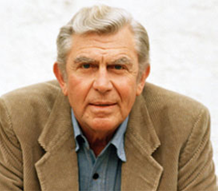
IDM: How did you get so many famous guests on your show?
David: “The very first celebrity guest I interviewed was Andy Griffith. I’ll never forget how nervous I was after he told me, ‘The last person that interviewed me was Larry King. I’m sure you’ll do just fine.’ I didn’t come close to filling the great Larry King’s shoes, but Andy and I did have a wonderful casual conversation that would set the theme of my show for decades to come. In 2009, the name of the show became ‘To Your Good Health Radio,’ and I’ve had the honor of interviewing many celebrities including Jay Leno, Howie Mandel, Jenny McCarthy, Suzanne Somers, and William Shatner, just to name a few. But what excites me the most is the variety of bestselling authors that I get to chat with and learn from. This includes leading pioneers in brain health (Dr. Daniel Amen and Dr. David Perlmutter;) pioneers for a plant-based diet (Dr. Joel Fuhrman, Dr. Neal Barnard, and Dr. Caldwell Esselstyn Jr.;) and the world’s leading Paleo Diet advocates (Robb Wolf, Chris Kresser, and Dave Asprey.) To be able to read an amazing life-changing book and get to pick the author’s brain while sharing that information with millions of people across the world; there is no greater reward.”
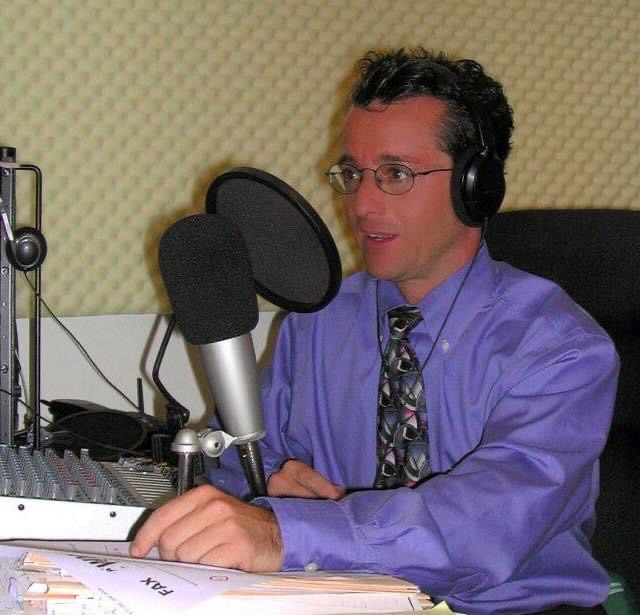

IDM: You’ve accomplished so much in life. What’s next on the horizon?
David: “I have several projects in the works. One is a documentary film based on my book Food Sanity. This is a bucket-list dream of mine because food documentaries can make a massive global paradigm shift. Look what the film Forks Over Knives did for plant-based eating and how Supersize Me convinced millions to stop eating at fast-food restaurants. Plus, not everyone will read a book from cover to cover but most people will sit down and watch an entire 90-minute documentary.”
Friedman continues to share, “I’m also writing the sequel to Food Sanity which will be more focused on weight loss and include healthful, easy to make recipes. In addition, I’ve just completed a comedy book based on actual events that have taken place in my office over the past three decades. The popular saying, ‘Laughter is the best form of medicine’ has been proven by science. According to the Journal of Neuroscience, laughter releases endorphins in the brain—our internal feel-good chemicals—via opioid receptors. Similar to opioid drugs, which also bind to those receptors, laughter induces euphoria, minus the negative side effects. laughter induces euphoria, minus the negative side effects. Laughter also activates the release of serotonin, the key hormone that stabilizes our mood, feelings of well-being, and happiness.”
IDM: Can you share a couple of funny stories from your upcoming comedy book?
David: “Sure. Since we chatted about John Travolta, I’ll share a funny story that involves him. One of my patients, a guy named Vince, told me he saw John Travolta coming out of the shower at the YMCA just as he was walking in. He stopped, looked at John standing there with no clothes on, and said, ‘Hi John, it looks like we have something in common.’ Travolta looked down at this naked man’s body and then glanced at his own and replied, ‘Uhm, I don’t think so.’ Vince proudly said, “Yes we do. We are both patients of Dr. David Friedman!”
Friedman went on to share another humorous story from his clinic, “A patient came in last week that I hadn’t seen in a while. She said, ‘I’ve been putting this off for nine months!’ I replied, ‘That’s exactly what my mom said the day before I was born!’ My patient then shared with me how she had recently gotten a new job but was thinking about quitting after learning about one of the benefits they offer. I asked her what benefit had her so concerned and she replied, ‘They’re offering all employees a 401K.’ I said, ‘And why is that a bad thing?’ She continued, ‘Dr. Friedman, with my bad back, I can’t even run a 5K. How am I going to survive a 401K?’ ”
Dr. Friedman shared one more quickie from his book, “During an initial exam I asked a patient to stand on the scale so I could weigh her. I was shocked to see she only weighed 80 pounds! I looked down and said, ‘Both legs please.’”
IDM: With all your professional milestones, what do you consider to be your proudest moment?
David: “That’s a tough one to answer. I would probably say interviewing Andy Griffith in 1995 for the exclusive feature cover story for Today’s Chiropractic Magazine, commemorating the profession’s 100th anniversary. His endorsement of chiropractic opened the minds of tens of thousands of senior citizens who had never considered trying this form of alternative medicine. What makes this such a defining milestone for me is, I visualized it taking place two years before Andy Griffith even became my patient. There are so many successful people that give visualizing the credit for their success. A reporter once asked Hank Aaron, home run hall of fame inductee, what’s the secret to being able to hit so many home runs? He replied, ‘Before I walk up to the plate, I visualize hitting that home run.’ Seeing something in your mind’s eye can have a profound effect on whether or not it comes to fruition. I visualized Andy not just becoming a patient of mine but feeling so great from my care that he would want to tell the whole world! And that’s exactly what happened.”
IDM: The Andy Griffith Show is one of the most successful and loved programs in television history. He played such a good ole, down-to-earth person. Was he like that in real life?
David: “Yes. I live in North Carolina and there is no other place in the world where the name Andy Griffith is more well-known.
In fact, the fictitious town of Mayberry was modeled after Mount Airy North Carolina, where Andy grew up. Even as popular as he was, every time he would walk into my office waiting room for his scheduled appointment he would say to my receptionist, ‘My name is Andy Griffith. I’m here to see Dr. Friedman. My last name is spelled G R I F F I T H.’ (Like everyone didn’t already know who he was.)
Andy would sometimes bring his banjo with him because he didn’t want to leave it in his Ford pick-up truck in the hot summer. One day a patient walked in and saw Andy holding his banjo and asked him if he would play a song. That ended up turning into a 45-minute concert in my waiting room. All my patients and staff gathered around and enjoyed this wonderful event. Not many people know this but Andy Griffith had a very successful music career. In fact, two of his records went platinum and he won a Grammy for Best Southern Gospel Album in 1997. He also sings and has appeared on several notable musicians’ records and videos including Brad Paisley, Randy Travis, and Marty Stewart.”
IDM: With so much going for you, what keeps you motivated?
David: “There are many people that stay satisfied being stagnant. While that is perfectly okay for some, I am motivated by movement. A ship at sea will never develop barnacles but a ship stagnant at the dock will. I want to leave a legacy, something that will profoundly benefit others even after I die. Whether that’s helping fix a father’s torn rotator cuff injury so he can play catch with his son and create childhood memories, or writing books, making films, or recording audios that can benefit many people’s lives.”
Friedman continues, “I had a patient ask me last week, ‘I see there’s a doctor’s office opening across the street from you. Are you sad to see more competition?’ I replied to her, ‘I didn’t even notice a doctor’s office was opening across the street. I stay so focused on what I do here that I don’t have time to be concerned about other businesses. I don’t consider any doctors’ office as my competition. The only competition I have is the reflection I see in the mirror. I want to see someone better today than I saw in that reflection yesterday. To answer your question, my motivation isn’t driven by what the Joneses are doing but rather, what can I do to make the Joneses want to alter their sails and keep up with me.”
IDM: As a health expert for Lifetime Television’s morning show you’ve covered a lot of health features and interviews. Which one stands out as your favorite segment?
David: “It would be my cutting-edge feature on the dangers of artificial sweeteners. Back then, no one knew they contained chemicals that caused disease and contributed to weight gain. I was the first person to go on national television exposing this not-so-sweet truth. It ended up being a two-part feature exposing the health risks of consuming artificial sweeteners. America spends $25 billion on diet soft drinks. People drink them to keep from gaining weight yet these diet drinks contain chemical sweeteners that stimulate appetite and contribute to obesity. A study at the University of Texas Health Science Center at San Antonio found that participants who drink diet soft drinks containing artificial sweeteners, increase their risk of obesity by 41 percent for every soft drink they consume. These sugar alternatives are formulated with an array of toxic chemicals that lead to imbalances in the body and have been linked to ailments like depression, arthritis, Alzheimer’s disease, and even cancer.”
Friedman shares, “Michael J. Fox’s Parkinson’s disease has been linked to his diet-soft-drink consumption and I wanted to include this in my feature. However, after the legal team at Lifetime Television reviewed the script, they excluded that part of the segment. They were concerned that there wasn’t enough proof, and, of course, that meant possible legal repercussions. I refused to sit back and allow such an important part of this feature to get the ax. I forwarded the powers that be a plethora of evidence, including compelling research conducted by James Bowen, M.D., and Arthur M. Evangelista, former FDA investigator, showing aspartame is a powerful neurotoxin. I included ‘Evidence File #6: Aspartame & Parkinson’s Disease’ submitted by Mark D. Gold with the Aspartame Toxicity Information Center. After reviewing this research and more, I was given the thumbs up by the legal team at Lifetime and my segment aired to rave reviews. I received over a thousand letters from happy viewers that got off artificial sweeteners following my segment. They felt better, could think better, sleep better, and could finally lose those unwanted pounds.”
IDM: In closing, what advice can you offer to help doctors become more successful, our readers, or anyone else that simply wants to become a better health influencer and gain momentum?
David: “Focus on what you can do for others instead of how it can benefit you. When you give unselfishly, it will come back to you tenfold. People often ask me how I was able to get so many celebrities as patients? I can trace it all back to the time I went to the set of the Brandon Lee movie, ‘The Crow.’ They were pulling 16-hour cold winter days outside onset and many of my regular patients couldn’t come to see me. So, I loaded up my portable table and brought it to the movie set. I ended up treating over 80 members of the cast and crew and I offered my services for free. It was my way of giving back to an industry that has supported me. I went on set several times giving away my services for those in need. Bob Rosen, the producer of the film, literally had a tear in his eye when he thanked me for helping everyone through such freezing cold, long, and physically challenging days.
Fast forward 28 years later and through the ripple effect, I can trace back virtually every celebrity patient I’ve seen since. They are all somehow connected to a production coordinator, hairstylist, make-up artist, or transportation guy that worked on the set of ‘The Crow.’ These folks have continued to share with others their wonderful experience under my care while working on that movie. This ripple effect from a genuine unselfish gesture was the catalyst to all the A-list movie stars I’ve seen since. The bible says, ‘You reap what you sow.’ In this scripture, sowing is used as a metaphor for one’s actions and seeing the benefits of such. If you believe in Karma, your good actions of influence toward others will bring an equal or greater amount back to you. We all need to make a living, but money will come to you when money isn’t your primary focus. Instead, work on helping others and the fruits of your efforts will be rewarded with amazing success and prosperity.” Www.drdavidfriedman.com
FB:· @Dr. David Friedman TW:· @drdavidfriedman LinkedIn: @Dr. David Friedman In: @drdfriedman
To View the Magazine To View or Buy the Magazine

